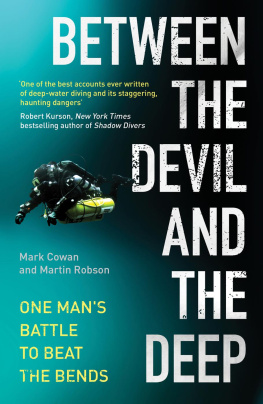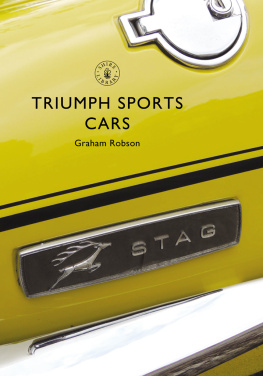
For Edik, Guardian of the Blue Lake
,
With special thanks to Otter Drysuits

A NOTE FOR READERS
Between the Devil and the Deep is, in the truest sense, the product of collaboration between Mark Cowan as the writer and the people whose story it tells. From the outset, Marks approach was to write as factual an account as he could, bearing in mind he was not present for the events described, one that would stand on its own as a piece of journalism. For that, he needed the trust and participation of the people involved. This narrative is based on his interviews with them, on their memoirs, diaries, on contemporaneous reports, online accounts, photographs and videos, and on simply hanging around with people, eating with them, sharing their space, moving with the rhythms of their life and observing them going about their business.
Recreating that period of January 2012 in such detail would not have been possible without the involvement of Martin Robson and his willingness to relive in great detail his experiences in Russia. Mark spent many hours speaking with him about the events. Martin answered his questions candidly and gave him access to files, notes, photographs and dive logs to support his answers. Martin allowed Mark, someone he barely knew at the outset, to intrude into an extremely personal period of his life and accepted his tireless questioning with good grace and humour. In that way, he became an active participant in the storytelling process, helping to recreate the scenes by dredging the recesses of his memory for the tiniest pieces of information. Martin also helped open the doors to a number of the people involved in the expedition and patiently guided Marks understanding of what it is like to dive well beyond the limits of ones comfort level. This book is the result of that collaboration, which is why both of their names adorn the front cover.
While Martin was, obviously, an active participant in the events being recounted, Between the Devil and the Deep is written in third person. This was a narrative choice to allow the book to take the reader to as many places as possible particularly as the rescue mission got under way including events that Martin was not party to. As Dr Gennady Sokolov was such a key figure in Martins rescue, treatment and recovery, the use of third person gave Mark the freedom to write about those events from the doctors point of view.
In August 2018, Mark accompanied Martin on his return to Russia and his reunion with Dr Sokolov. The doctor and his colleagues warmly welcomed the two men into their Institute. They took great pride in showing Mark and Martin around and talking about the groundbreaking research that had been conducted there. Dr Sokolov was gracious with his time and answered as many questions as Mark could ask. They also got to see the doctor run the chamber for a team of divers on a deep dry dive to one hundred metres. The visits to the Institute bookended the trip in which Mark and Martin followed as closely as possible Martins original route to Kabardino-Balkaria and Blue Lake. Many people there looked after their welfare, made travel arrangements, interpreted conversations and facilitated a dive in Blue Lake. If one person should be singled out it is Eduard Khuazhev for his hospitality as he took care of them in his hometown of Nalchik.
For the writer, being immersed in the world about which they are reporting can reveal important insights that may not otherwise be available. In some respects, Mark was lucky because he had been a diver for a decade when he first met Martin and started to report his story. To understand the allure of cave diving, he went to Mexico to learn. The hours spent underwater in the middle of the jungle with experienced cave diving instructor Christine Loew opened his eyes to a world beneath his feet, and a subculture of fascinating people. To gain an insight into the work of the technicians who operate recompression chambers, Mark spent time with a friend and recompression chamber technician, Robbie Renalson, and his team in Rugby, UK. Watching them treat a diver suffering the effects of decompression sickness following a holiday dive was particularly helpful.
Even with this understanding, recreating the events of an expedition presented the writer with some obvious problems, among them the conversations people shared. Mark had originally considered dramatising dialogue but feared it might devalue the efforts of reporting. Therefore, no dialogue is invented. Anything that appears in direct quotes was captured by Mark during interviews, is quoted from published material or from personal correspondence. Where this is the case, it has been made clear in the text or in the Notes on Sources.
To research the history of decompression sickness Mark relied on the British Library and the National Archives, Kew, which hold a wealth of books and documents dealing with this long-forgotten story that proved crucial in his research. For records of depths that divers reached during the early days he chose to use the language they used in the spirit of adding authenticity to the text. Where necessary, a conversion to more recognised measurements has been added in parentheses. While the writer acknowledges this choice does not provide a uniform approach throughout the book, it does highlight the changing language of diving.
These historical accounts highlight the painstaking work done by some brilliant minds who set out in search of a solution to the problems of decompression sickness, and to develop safe diving procedures. In telling their stories, Mark would not want any mention of the difficulties they faced to be misconstrued as criticism. The aim was to show how much time and effort they expended on the Herculean task of creating and validating workable diving tables that all divers rely on, and many take for granted. Divers will forever be indebted to the huge number of people whose research over the years has allowed them to explore underwater. Decompression sickness will inevitably remain part of diving, particularly for those mounting significant dives in terms of depth or duration underwater, but those who feature in the pages of this book, along with those who dont, have all made lasting contributions to improving the safety of the sport.
Perhaps the most challenging part of the book was capturing what was going on inside Martins body at the time. Even with current thinking, those details are something that is not fully known. It is exactly that unknowable element, though, that made the book so compelling to research, report and write. Guided by the thoughts, opinions and academic research from some leading experts in the field, Mark chose to include several possible explanations to drive the narrative without drowning readers under the vast weight of technical theories. Having used those hypotheses to tell an interesting story, he fully acknowledges that new research could throw up other possibilities in the future. He didnt set out to write a treatise on decompression sickness the subject is too big and there are many people more qualified and better placed to do that.
Finally, Mark also acknowledges that the phrase the bends is not perfectly synonymous with decompression sickness, despite its use as such by laypeople. Originally, the term was a descriptive one to highlight joint or limb pain. With time, it has come to be used as a generic term for decompression disorders. Within the medical profession a classification system has been established to help better recognise the signs and symptoms of the illness. While the writer has tried not to rely overly on the term the bends, it has sometimes been used it in its more colloquial meaning for brevity, rhythm and to recognise its everyday usage.












